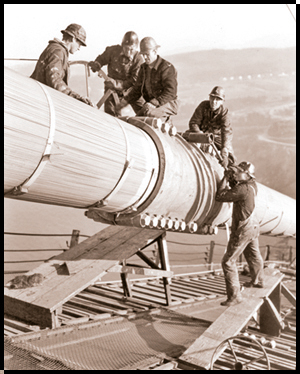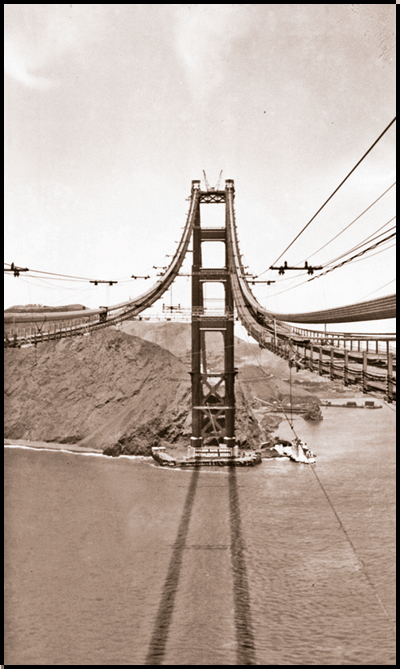Over four years of construction, the safety net saved the lives of 19 men. They called themselves members of the "Halfway to Hell Club."
For nearly four years, the Golden Gate Bridge project seemed charmed with an almost perfect safety record. And then, one day, everything changed.

Photo by the Golden Gate Bridge, Highway and Transportaion
District, used with permission, www.goldengate.org
The Collapse
On February 17, 1937, the day's task was to remove a wooden scaffold that had been built underneath the bridge platform. To reach it, workers had hung a temporary catwalk. Each time they stripped off a section of wood, workers would move the catwalk another few feet.
"As they started to move it," recalled Adams, who was standing nearby, "that's when it went down. 9:20 in the morning, it went down."
The catwalk hadn't been attached properly. It broke off and plunged into the ocean, dragging the safety net with it. Fred Brusati was working nearby when he heard someone shout that the catwalk had fallen. He rushed over to the side and saw a man clinging to a piece of steel. Brusati and a few others threw a rope to the man and hauled him up to safety.
"The man had a pipe in his mouth," recalled Brusati. "He didn't drop the pipe or nothing. He just started to walk toward San Francisco, and I never did see him back there again."
The real tragedy was below. Twelve men had fallen 220 feet into the water. One of them was Slim Lambert. "People ask me, 'what went through your mind?' The only thing that went through my mind was survival," he says. "I knew that to have a prayer, I had to hit the water feet first."
But when Lambert hit the water his legs tangled in the safety net.
"That's the only time I panicked during that whole thing," said Lambert. "I was caught in the net, and the net was headed for the bottom."
Lambert plunged so deep that when he surfaced he was bleeding from his ears. Bridge debris was everywhere. "I got a couple of planks together for myself first, and then I saw Fred thrashing about. So I got him."
Fred Dummatzen was 24 years old. Lambert pulled him up onto the planks and waited. "I heard this power boat ... put, put, put," he said.
It was a crab fisherman, coming in from sea. Lambert recalled there was so much junk floating in the water, he worried the driver would pass right by. "He took another look around and his eye hit me. What a relief. I figured, by gosh, we're gonna make it."

Dummatzen died on the crab boat. But Lambert and another man, a 51-year-old carpenter named Oscar Osberg, survived the fall. Today, a plaque at the entrance on the southwestern side of the bridge is dedicated to the 10 men who died that day.
Currie says the workers she has talked with don't really remember the cold or the danger. They felt lucky to be there.
At a time when the rest of the country was struggling to get by, six Bay Area counties agreed to spend what seemed like a fortune on a suspension bridge longer than any the world had ever seen.
"It was the people who had to rise up and see this as a symbol of hope, imagination, stick-to-itiveness," says Currie. "They saw this bridge as something that would change their lives."
And that, she says, was a pretty gutsy thing to have done.
-----------
This article was reprinted with permission from QUEST Northern California, KQED.
Return to page one of Life on the Gate